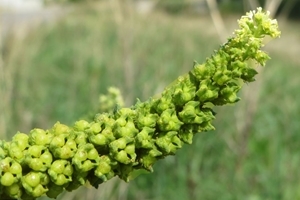Weld
 Weld (Reseda luteola) is a common plant in my neck of the woods here in Hampshire, where it grows on waste ground, arable field edges and along woodland rides - in fact, just about anywhere that light soils have been disturbed. A couple of years ago, quite a lot of clear felling of trees took place in my local wood and the whole area became yellow with flowering weld. Its tiny seed had been lying dormant, perhaps for many decades, waiting for just such an event to happen.
Weld (Reseda luteola) is a common plant in my neck of the woods here in Hampshire, where it grows on waste ground, arable field edges and along woodland rides - in fact, just about anywhere that light soils have been disturbed. A couple of years ago, quite a lot of clear felling of trees took place in my local wood and the whole area became yellow with flowering weld. Its tiny seed had been lying dormant, perhaps for many decades, waiting for just such an event to happen.
When I say that weld has a tiny seed – I mean it! It almost looks more like dust than actual seed and I noticed that one seed supplier was selling it by the packet of 1.5 grams, which contained approximately 6,500 seeds!
It is a biennial plant that can grow up to five feet in height, and its long spikes of small, pale yellow flowers start appearing in early June, attracting bumblebees and many other insects. It is probably a native plant to the UK in southern regions, although there is some debate over this, but was undoubtedly spread by humans to all parts of the UK except the uplands, as it was valued as an ancient dye plant, giving it one of its other common names of dyer’s rocket or dyer’s weed.
Weld is an ancient dye plant. The Greek writer Dioscorides, in the 1st Century AD, listed weld as a plant widely used for dying cloth a vibrant yellow, and the Romans also used weld to dye wedding garments, and apparently the robes of the Vestal Virgins. Weld overdyed with woad (a blue dye) makes Lincoln green, which was the colour associated with Robin Hood and his merry men back in the 13th Century.
The leaves have the most intense dye, but the whole plant (except roots) contains dye. It is especially good when used on wool, cotton and silk. When combined with a mordant, which helps the dye or stain “fix” to the material, weld makes a bright lemon yellow on wool and silk; with copper it makes greenish yellow; with iron it makes olive.
There has been a history of growing weld as a crop in this country, especially around Canterbury in Kent, but also in Essex and Yorkshire. When stocks were low, harvested weld was brought in from France, where it was also widely grown. Indeed, it is still grown commercially in Normandy and used in dyeing silk, as no synthetic dye has really been able to replace it in this function.
Weld yellow has been also been identified in paintings by Vermeer, Rembrandt, Van Gogh and Aelbert Cuyp. Indeed, in 1994 when experts were restoring Vermeer’s Girl with a Pearl Earring, it was discovered that he had glazed the whole background, initially painted in black, with a mixture of indigo and weld, which, together, produced a deep, transparent green.
So keep an eye open for this plant of disturbed ground, which has brought so much rich colour into our lives, and while in flower, rarely appears to be without an attendant bee!
Peter Thompson
Advisory
Read more from Peter Thompson at his blog.

Download Peter Thompson's essential 26-page book, featuring beautiful photography and detailed profiles of Britain's wildlife
Download FREE >